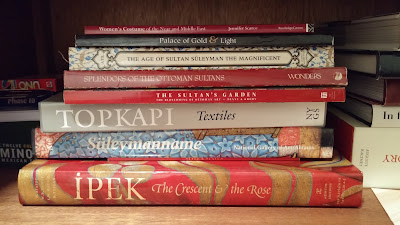Late 15th Century Florentine Dress Using an "English Kirtle"
In late 15th century Florence, the waistline for the bodices of gamurra (kirtle or underdress) and giornea (the draped overgown) are still very close to the natural waist. They are not raised as high as we see in Venice at this time period. This makes the basic supportive dress rather similar to what we see in England and Northern Europe at the turn of the 16th century.
Domenico Ghirlandaio, detail from Birth of John the Baptist, 1480s, Florence Santa Maria Novella. Abside. Cappella Maggiore. Chapelle Tornabuoni. Costanza Caetani, in the style of Domenico Ghiarlandaio, 1480s. National Gallery UK.
I chose to style this Florentine look as a bit fancier than the other two, more of an upper middling sort or even upper class, but it could be styled as more solidly middle class by changing the materials of the sleeves and omitting the partlet. The gamurra in Florence is frequently seen lacing up the center front, most often with lacing rings, but eyelets are an option. It is still too early in period to find boning in the bodices, and as shown in the paintings, the Florentine silhouette has a more rounded bust than the English, making the probability of boning very low. One main difference I spotted with the gamurra bodice is the neckline has a more rounded shape and is usually cut higher than in England.
Domenico Ghirlandaio, Portrait of a Young Woman, circa 1490. Museu Calouste Gulbenkian.
The linen undergarment was called camicia in Italy. It has rectangular construction, and is gathered to a neckband. Mine has gathering stitches on the cuffs to give it a little ruffle. The sleeves are cut very full to allow for puffs of fabric to show. There are many patterns to be found, I suggest Margo Anderson's.
The sleeves on my outfit are separate and made in two pieces. I chose to have the side seams open to allow the camicia to puff through, as was commonly seen in portraiture. My sleeves are made from a light green silk taffeta and lined with green linen, and they are reversible. If I wear them with the linen side showing, it's more appropriate for a middle class style. The sleeve ribbons are made from silk for an upper class look; I would switch them to something like cording to make it less fancy. Sleeves could be tied on or, perhaps more commonly seen, stitched on at just the top of the sleeve head.
Partlets can be seen in the paintings of upper class women, usually from very sheer material. I have read three different terms for partlet in Italian: coletti, fazzoletto, and giorgeria. These could be very fine linen or possibly silk. I chose silk gauze for mine. My coworker Christina did the stitching because I was struggling with the rolled hem on the gauze. We plan to revisit the shape and which direction the fabric will be cut to prevent stretching.
Luca Signorelli, Stories of Saint Benedict in Monte Oliveto Maggiore, late 15th c. |
I made a coral necklace like the portraits show. Mine is faux coral because actual coral is endangered and I did not want to contribute to that, and I found vintage coral too expensive. I am also wearing a black silk girdle belt with tassels. Later on I plan to make a giornea, a draped overgown, when I want a more formal look. For a middle class or working woman style, I will wear the same white linen apron I made for my "German" look, as it's very similar to the Italian ones (and is actually correct for most European impressions between 1450-1600).
Domenico Ghirlandaio, Pope Gregory announces the death of Santa Fina, Collegiate Church of San Gimignano (about 1477).
Lorenzo de Credi, Portrait of a Girl. Berlin
Websites I recommend:
An extant gamurra and the Fleurty Herald aka la Bella Donna Historical
Festive Attyre's Research on Florentine Dress













The fabric of the outfit should of the high-quality. For ethnic outfits, silk is one of the best choices. Go for the specific fabric like chiffon, cotton, linen or silk that can make the wear look perfect. The fabric can make the clothing glamour for the wearer. spa facial machine
ReplyDelete